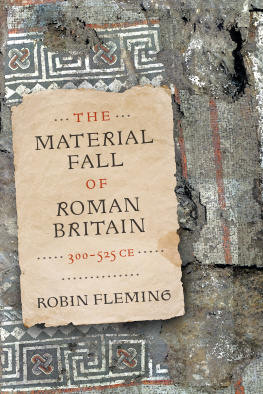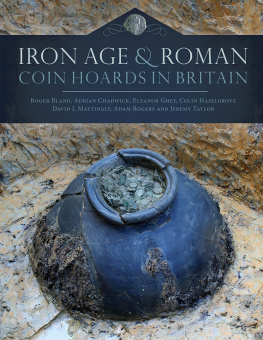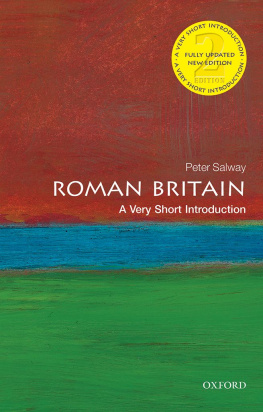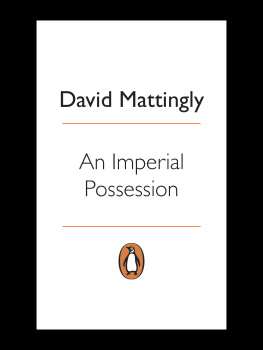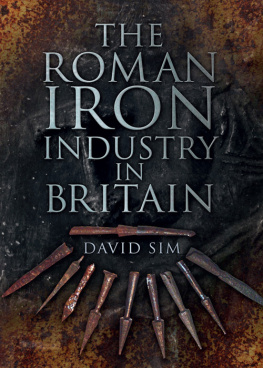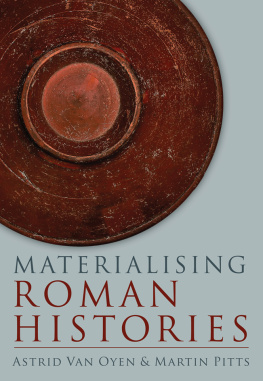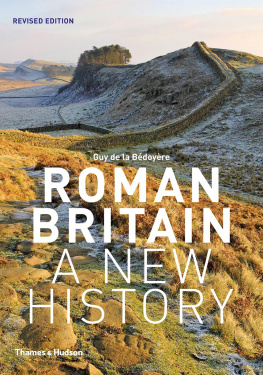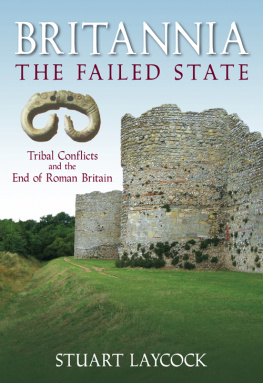The Material Fall of Roman Britain, 300525 CE
THE MATERIAL FALL OF ROMAN BRITAIN, 300525 CE
Robin Fleming
Copyright 2021 University of Pennsylvania Press
All rights reserved. Except for brief quotations used for purposes of review or scholarly citation, none of this book may be reproduced in any form by any means without written permission from the publisher.
Published by
University of Pennsylvania Press
Philadelphia, Pennsylvania 19104-4112
www.upenn.edu/pennpress
Printed in the United States of America on acid-free paper
10 9 8 7 6 5 4 3 2 1
Library of Congress Cataloging-in-Publication Data
Names: Fleming, Robin, author.
Title: The material fall of Roman Britain, 300525 CE / Robin Fleming.
Description: 1st edition. | Philadelphia : University of Pennsylvania Press, [2021] | Includes bibliographical references and index.
Identifiers: LCCN 2020044286 | ISBN 978-0-8122-5244-6 (hardcover)
Subjects: LCSH: Material cultureGreat BritainHistoryTo 1500. | Great BritainAntiquities, Roman. | Great BritainAntiquities. | Great BritainCivilizationTo 1066. | Great BritainHistoryRoman period, 55 B.C.449 A.D. | Great BritainHistoryAnglo-Saxon period, 4491066.
Classification: LCC DA145 .F58 2021 | DDC 936.2/04dc23
LC record available at https://lccn.loc.gov/2020044286
For Susan Reynolds, who taught medieval historiansespecially meto mind our language
What we are being offered is a chronicle of changing perceptions, at family level, by people who may or may not have been aware of their future role as historical actors. This might be a disappointing conclusion for students of history, but is an exciting prospect for students of people.
Martin Carver, Catherine Hills, and Jonathan Scheschkewitz, Wasperton: A Roman, British, and Anglo-Saxon Community in Central England
CONTENTS
The Bibliography appears online at the following address: https://repository.upenn.edu/fleming_material-fall
The Material Fall of Roman Britain, 300525 CE
INTRODUCTION
Down a Rabbit Hole?
But, when the Rabbit actually took a watch out of its waistcoat-pocket, and looked at it, and then hurried on, Alice started to her feet, for it flashed across her mind that she had never before seen a rabbit with either a waistcoat-pocket, or a watch to take out of it, and burning with curiosity, she ran across the field after it, and was just in time to see it pop down a large rabbit-hole under the hedge. In another moment down went Alice after it, never once considering how in the world she was to get out again.
Lewis Carroll, Alices Adventures in Wonderland
I am a historian, not an archaeologist, but almost two decades ago, as I settled into a new book projectI was writing the early medieval volume of the Penguin History of BritainI began reading archaeology seriously for the first time in my career. The authors of these retrospective texts framed the past in ways that would have made sense to contemporary audiences, especially their twin assumptions that Anglo-Saxon kings and their war bands were the periods only historical actors and that these men had rapidly taken power in lowland Britain after Romes withdrawal. Three consecutive entries in the Anglo-Saxon Chronicle will suffice to illustrate how this plays out in our sources:
In the year 495, two chieftains, Cerdic and his son Cynric, came with five ships to Britain at the place which is called Cerdicesora, and they fought against the Britons on the same day. In the year 501, Port and his two sons Bieda and Mgla came to Britain with two ships at the place which is called Portsmouth, and there they killed a British man of very high rank. In the year 508 Cerdic and Cynric killed a British king, whose name was Natanleod, and 5,000 men with him; and the land right up to Charford was called Netley after him.
Although the Chronicles portrayal of the past doubtless rang true to the better sorts of people living at the time of its compilation, there are good reasons for thinking that we should be more skeptical. One of the things I learned, as I plowed through the stacks of excavation reports on my desk, is that the mass of contemporary evidencewhich is material rather than textualstrongly argues that people in lowland Britain in the fifth century were much more concerned with subsistence agriculture than warfare, and that almost all of them lived in highly circumscribed worlds in ranked rather than steeply hierarchical communities. My reading also brought home the fact that most individuals and households during the first four or five generations after Romes fall were closer to poor than rich, not something one gleans from a close reading of Bede or the Anglo-Saxon Chronicle. This fundamental fact is missing from our interpretations of the period, not only because we historians often limit ourselves to the study of texts produced by and for elite men, but because most of us are not fully aware of the material prosperity found in Britain before Romes fall.
I came to learn from my reading of archaeology that the people living in this period who were not weapon-bearing men engaged with the world and its problems in ways that would be fundamental in Britains eventual transformation from Roman to early medieval, but that most of the important work they undertook never appears in annals, histories, or saints lives. As I puzzled my way through the archaeology, I was surprised by how much evidence there was for those great crowds of people mostly missing from our textswomen, children, farm families, part-time craftspeoplein other words, the kinds of individuals who actually made up the overwhelming majority of all those living in lowland Britain. It was the collective actions of these people, that is, the ones who generally have no place in either our early medieval texts or our modern historical treatments of the period, that stood behind many of the periods most crucial transformations.
My reading of the material evidence also suggested that on the whole historians and archaeologists of Anglo-Saxon England have not thought hard enough about Britains large, indigenous population once the Anglo-Saxons arrive on the scene. In most treatments, the indigenous population either rapidly exits stage left or is cast as the losers in an epic saga of one ethnic groups triumph over another. As a result, native British peoples part in the story of the making of early medieval England has not been well served, in spite of the fact that several million of them lived through the generations of transition. The day these various realizations finally sank in marks the day that I threw myself headfirst into the archaeological literature and what I feared to be a great, gaping rabbit hole. What I learned, instead, was that it was not a rabbit hole at all, but rather an immensely complicated and revelatory space. Indeed, as I finished this book on the late Roman material culture regime in Britain at its end, it is clear that I am never going to claw my way back out of the evidentiary world into which I have fallen. Not only have I established permanent residence down here, but I hope that my book and I can lure other historians down the rabbit hole with us, so that we can show them the kinds of things one can see down here that one cannot see anywhere else.

